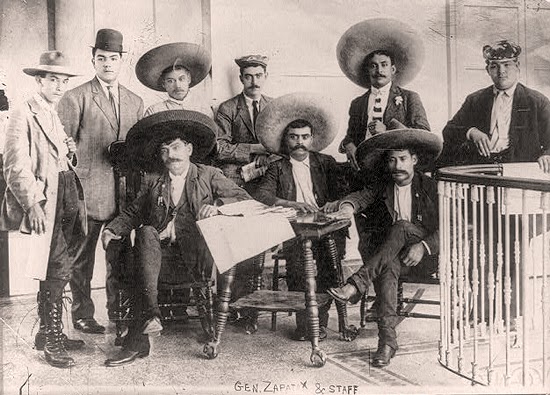 |
| Emiliano Zapata |
Ranking high in the pantheon of Latin American heroes, the Mexican revolutionary Emiliano Zapata gained widespread popular acclaim for his uncompromising demand for "Land and Liberty" (Tierra y Libertad) and for his courageous, principled, and shrewd leadership of his Zapatista army during the Mexican Revolution (1910 - 1920).
During the revolution and after, Zapata came to symbolize the hopes and aspirations of Mexico's poor and downtrodden in their struggle for land, dignity, and social justice. Zapata embodied the agrarian and Indian impulses of the revolution.
Born in the Indian village of Anenecuilco, Morelos, to smallholding parents Gabriel and Cleofas Salazar Zapata, in 1909 he was elected president of the village council, a rare honor for a man only 30 years old. These were troubled times in Morelos.
  |
In the previous decades under the presidency of Porfirio Díaz, the process of capitalist transformation had led to growing landlessness and poverty among the village's nearly 400 residents, as it had across Morelos and much of the rest of Mexico.
When wealthy liberal reformer Francisco Madero announced his Plan of San Luis Potosí on November 20, 1910, calling for "no-reelection" of the dictator Díaz, Zapata did not immediately endorse the plan. Within a few months, however, he allied with the Maderistas, achieving several victories against federalist troops in Morelos.
 |
| Emiliano Zapata and his staff |
After Madero's forces toppled the Díaz regime, Zapata insisted that lands stolen in previous decades be restored to their rightful owners. Madero balked, requiring demobilization of the Zapatista forces. When one of Madero's generals, Victoriano Huerta, launched a campaign against the Zapatistas in Morelos in August 1911, Zapata was infuriated.
He soon withdrew support for Madero. Henceforth, Zapata pursued an independent course, fighting for what he understood to be the revolution's core issues: land and liberty for the poor, landless, and oppressed.
In November 1911 the Zapatistas issued their famous Plan of Ayala, which guided Zapata's army for the remainder of the revolution. Excoriating Madero as a tyrant and traitor, the plan declared that "the fields, timber, and water which the landlords, científicos, or bosses have usurped, the pueblos or citizens who have the title corresponding to those properties will immediately enter into possession of that real estate of which they have been despoiled by the bad faith of our oppressors. . . ." The Plan of Ayala met fierce resistance from both Madero and the Huerta regime that followed Madero's overthrow in February 1913.
The Zapatistas became the most powerful revolutionary force in southern Mexico after 1911, at one point dominating not only Morelos but Puebla, Oaxaca, and Guerrero states. When "Constitutionalist" leader Venustiano Carranza seized power in August 1914, Zapata and Francisco "Pancho" Villa allied against him.
Three times Zapata's forces occupied Mexico City. After most of the fighting had subsided, Zapata returned to his home state, where he was assassinated by Carranza's emissaries at the Chinameca hacienda on April 10, 1919.
His name and legacy remain popularly revered throughout Mexico, as seen most recently in the Zapatista National Liberation Army in the mostly Maya Indian state of Chiapas, whose rebellion against the Mexican government, launched in 1994, still simmered more than 13 years later.